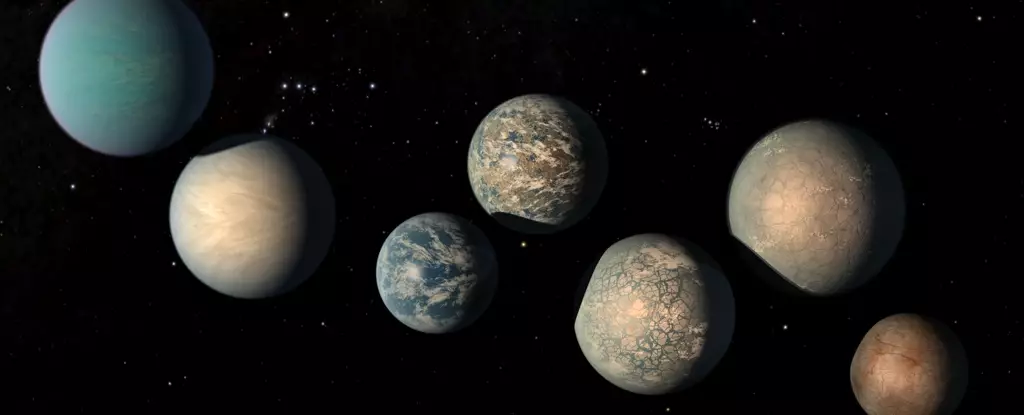In the ever-expanding quest to uncover extraterrestrial life, the TRAPPIST-1 star system stands as a beacon of intrigue, with its unique constellation of seven rocky planets orbiting a red dwarf star located a mere 40 light-years from Earth. Since its discovery in February 2017, by a team of astronomers using the Transiting Planets and Planetesimals Small Telescope (TRAPPIST), this system has captivated the scientific community and the public alike. The dynamic nature of this research—spurred on by advancements in telescope technology, particularly the James Webb Space Telescope (JWST)—has led us to consider not just the existence of these planets, but their potential to harbor life as we know it.
Water: The Essence of Life
Water is an essential component for life as we understand it, and the possibility that TRAPPIST-1’s planets might be swimming in it has caused scientists to take notice. Recent findings suggest that these intriguing worlds may possess significant amounts of water, just as researchers have debated the nature of their atmospheres. However, the continued focus on red dwarf stars like TRAPPIST-1, characterized by their smaller size and intense flare activity, presents a paradox. While they might offer conditions conducive to the presence of water, they also raise questions about the stability of any atmospheres and the retention of water over extended periods.
Atmospheric Dynamics in TRAPPIST-1
Initial research indicated a variety of atmospheres across the TRAPPIST-1 planets, provoking comparisons to Venus. However, recent data from JWST has started to paint a more nuanced picture. For instance, observations of TRAPPIST-1 c have ruled out the existence of a thick carbon dioxide atmosphere, suggesting that this planet may not be as “uninhabitable” as once thought. Nevertheless, crucial to this narrative is the confirmation of water vapor or potential oxygen produced through chemical processes. This insight is pivotal as it strengthens the argument that these worlds might sustain atmospheric water in their current state.
The Role of Volcanism in Sustaining Water
Astrobiologist Trent Thomas and his team at the University of Washington delve deeper into the complexities of maintaining water on TRAPPIST-1 planets. One of their compelling assertions posits that volcanic outgassing could be a mechanism for retaining atmospheric water. The study develops a theoretical outgassing model grounded in the geological characteristics of familiar rocky planets like Earth and Mars. The results suggest varying outgassing rates among the TRAPPIST-1 planets ranging from 0.03 to eight times those of Earth, a wide margin that could mean either a promising reservoir or a lackluster water source.
Interestingly, while the analysis pointed out that these planets might exhibit magma movement similar to that of Mars, they also indicated a likelihood of low or negligible volcanic activity. This implies that while there may be water present, the dynamics supporting its persistence could be weak, raising questions about the habitability of these worlds.
A Spectrum of Possibilities: From Dry Rocks to Water Worlds
The findings regarding mantle compositions have provoked fresh questions about the nature of TRAPPIST-1 planets. With evidence suggesting that these rocky worlds may have relatively dry Earth-like mantles, researchers speculate whether they could exhibit conditions range from barren landscapes to thriving aquatic environments. Notably, while Earth’s surface is about 71% water, it constitutes only a minuscule fraction of its total mass. This dilemma leads to a tantalizing prospect: could there be ‘water worlds’ amongst the TRAPPIST-1 planets, or are they more akin to dry terrestrial spheres?
Such comparisons prompt further exploration into the geological history and potential future of these exoplanets. Their capacity to maintain water may hinge not just on their proximity to their star but on their geological activity—or lack thereof—which appears to be a crucial factor in understanding their habitability.
The Road Ahead: Navigating the Unknown
As studies surrounding the TRAPPIST-1 system progress, it is clear that numerous questions remain unresolved. What lies ahead is a fruitful period of exploration and data collection, where continuous observations from the JWST and similar telescopes will refine our understanding of cosmic habitability. Each new finding potentially reshapes the narrative surrounding these seven planets, challenging us to reconsider our understanding of life and its far-off counterparts. Far from an endpoint, the TRAPPIST-1 puzzle offers a rich tapestry of mysteries awaiting untangling, affirming the notion that our universe is teeming with possibilities.


Leave a Reply